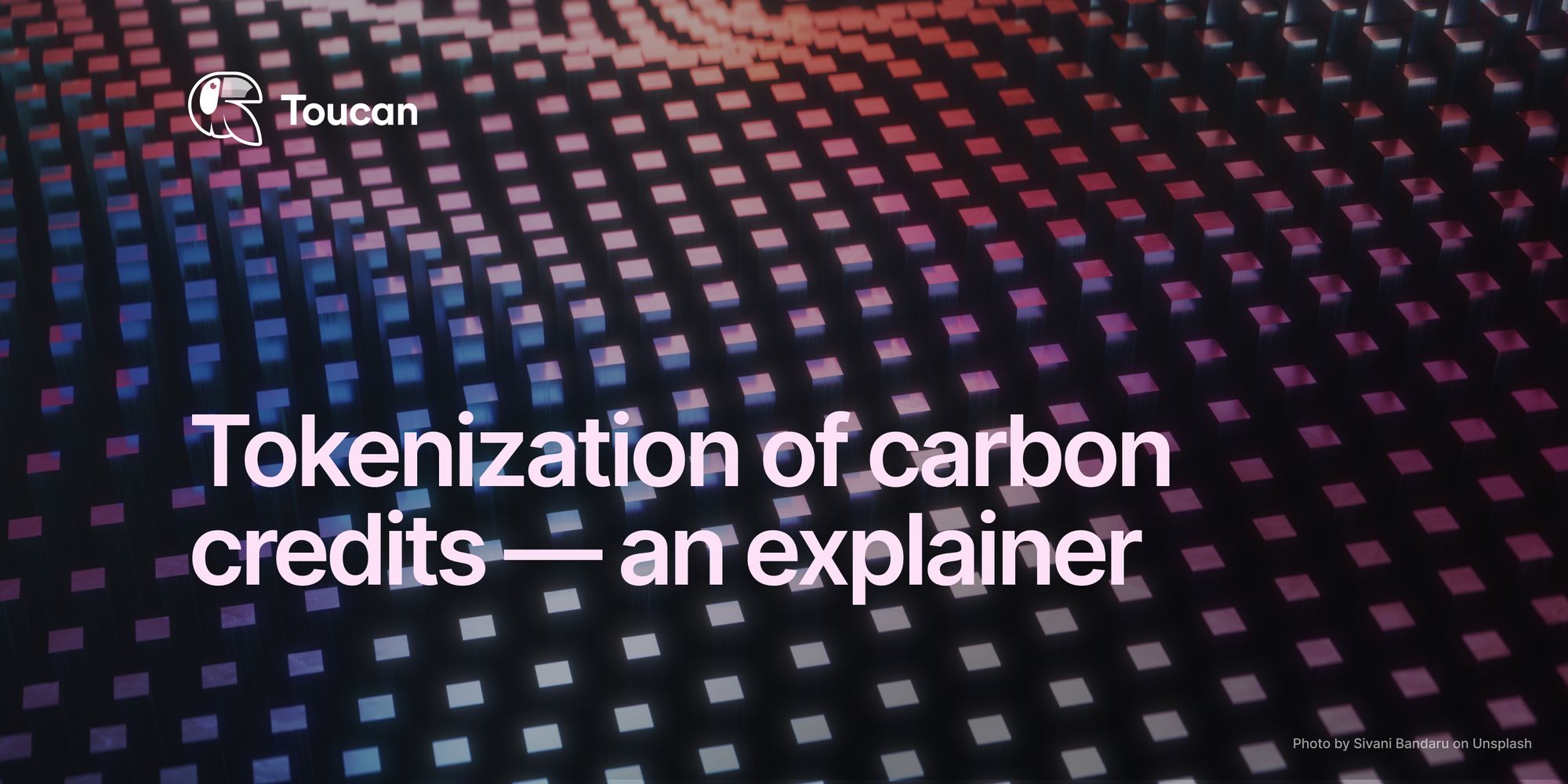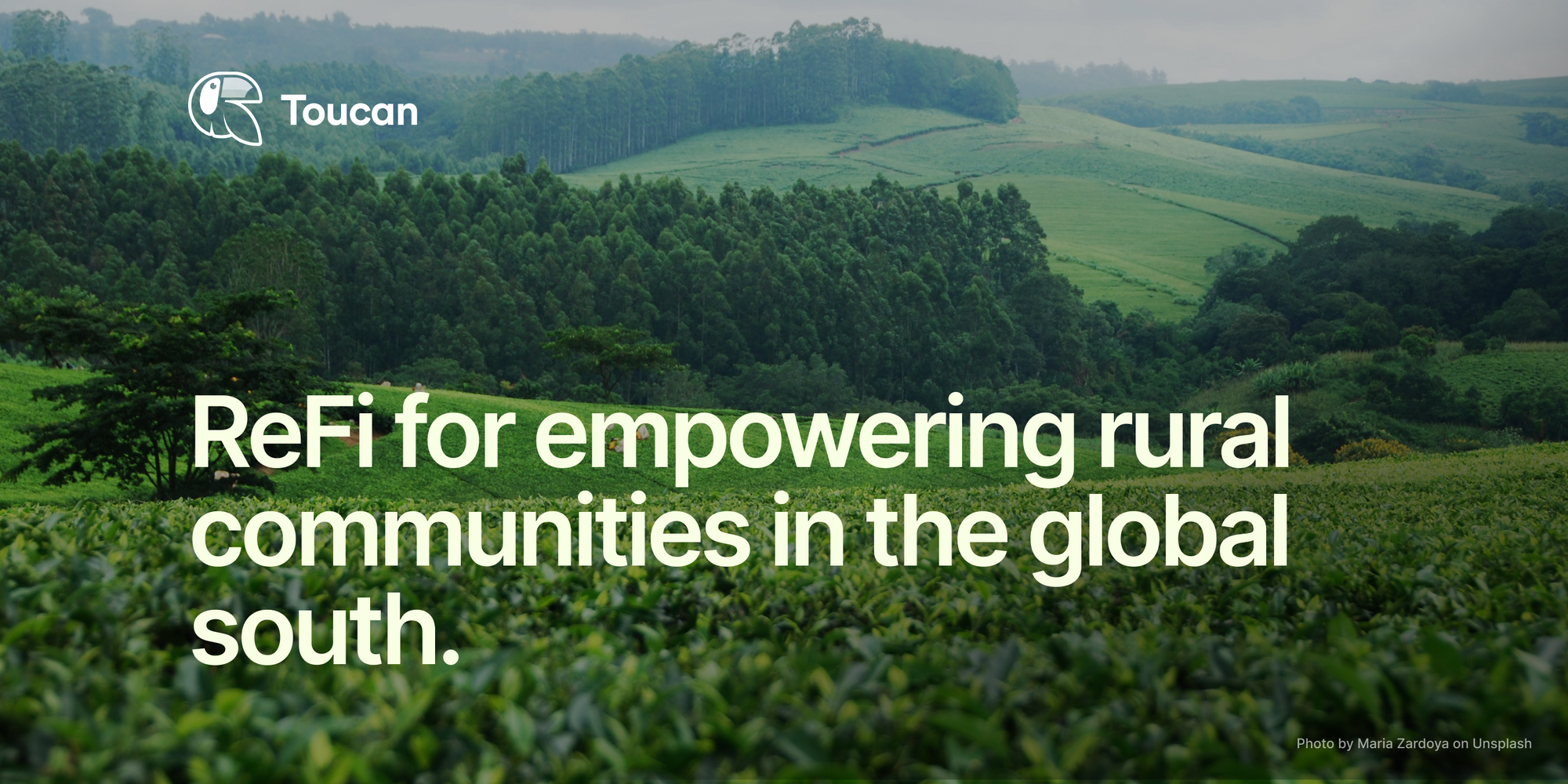Key terms in the Digital Carbon Market (DVCM) — explained
What is tokenization? What is DeFi? What is composability? We're explaining some of the most commonly used terms and concepts in the DVCM.

If you're just starting to get familiar with digital carbon markets, you might find the space to be full of jargon and complicated terms. This can be a little overwhelming for newcomers. To help new users and climate tech builders, we have compiled a list of frequently used terms that are relevant to the Digital Carbon Market (DVCM). This little glossary will provide you with a better understanding of the language and concepts unique to this sector. We define everything from Web3 🌐 to Regenerative Finance (ReFi), and also explain concepts like tokenization, fungibility, and protocols.
Browse through this piece, or jump straight to the term you're most interested in 👇
- What is Web3?
- What is blockchain technology?
- What is a cryptocurrency?
- What is the difference between cryptotokens and cryptocurrencies?
- What is a stablecoin?
- What is tokenization?
- What is a protocol?
- What is a cryptocurrency wallet (and when do I need one)?
- What is a smart contract?
- What is interoperability or composability?
- What is fungibility?
- What is a non-fungible token (NFT)?
- What is DeFi or Decentralized Finance?
- What is ReFi?
- What is a Regen?
What is Web3?
Web3 is a nascent movement and set of design principles to build a user-centric internet.
Web3 utilizes blockchain and decentralized technologies, which enable greater transparency, trust, and open collaboration.
Web3’s key traits are:
- It is decentralized.
- It is transparent.
- It is accessible to everyone.
- Everyone can expand on existing services (interoperable), without having to ask for permisson.
- Its users value collaboration, community-driven developments, transparency and autonomy.
Looking back in history, the first iteration of the internet (Web1) was a read-only medium — people uploaded websites that others could access. The second iteration (Web2) allowed users to contribute to the web, by adding their own content. Facebook and Instagram are typical Web2 products. Finally, Web3 enables users to read, write and also own and control their data and content — imagine being able to sell your best-performing Twitter post as an artwork!
Web3 applications span democratic digital governance systems, decentralized applications (dApps) for financial and other services, digital public goods (for example currency exchanges that aren’t owned or controlled by a company), and a variety of metaverses and digital games that are all connected.
Web3 aims to address some of the limitations of Web1 and Web2, ie. censorship of content, or entry barriers for users of certain backgrounds.
What is blockchain technology?
Simply put, a blockchain is a specific type of database that is powered by a distributed ledger system.
This means that no single party can decide to change or put up rules and restrictions. In comparison, “normal” databases are stored on one or more servers controlled by centralized parties. The server owners can change data, limit functionality, or implement rules that users have to adhere to.
Blockchains are maintained by a consensus network, and many computers (called “nodes”) work together to agree on the state of the database, as it gets updated over time. This consensus network plays a similar role to conventional “servers” or “clouds”.
Databases are updated via “transactions” — these are instructions that users of the blockchain send to the consensus network. A transaction could, for example, be transferring a digital asset from one user to the other. When sending the asset, the user's account prompts the network to update the database.
Blockchains can be public or permissioned. Everyone can use public (or open) blockchains: Any node can contribute to the consensus network, and anyone can create an account on the blockchain and use its applications. Ethereum, Bitcoin, Celo or Polygon fall into this category.
Permissioned blockchains (ie. Quorum) are more restrictive, and users might need to apply or register before being able to participate.
What is a cryptocurrency?
It's a digital-only unit of account whose transactions are stored on a blockchain. Cryptocurrencies are often referred to as "digital" or "virtual" currencies because they do not have a physical counterpart (like coins or bills). They can be issued by a central authority, ie. a government, a company or project, or a community. Since cryptocurrencies are powered by blockchain technology, every single transaction is publicly recorded, and their history cannot be altered or changed.
Sending and receiving cryptocurrencies is fast, secure, and it happens without the involvement of a third party (like a bank).
Cryptocurrencies can function as a virtual accounting system and a decentralized means of value exchange, and they can be designed around anything people are willing to pay for — ideas, participation, and more.
What is the difference between cryptotokens and cryptocurrencies?
Cryptocurrencies are often used as a means of storing value, and they are typically homogeneous and denominated in a single unit (ie. Bitcoin). Cryptotokens, by contrast, differ more in their utility. They can function as a payment tool, help distribute voting rights, give access to applications, or signal participation in a community-driven initiative or event. Cryptotokens can also allow people to invest in Web3 companies, where they function much like shares. Even NFTs (which you might know primarily as artworks) are tokens — the term “non-fungible token” gives this away!
What is a stablecoin?
These types of cryptocurrencies are pegged to specific real-world currencies, for example the USD. Stablecoins don’t fluctuate in price, and are a good way to hold cryptocurrencies without exposure to volatility. Popular stablecoins are USDC and DAI, both of which are designed to maintain a value of 1 US dollar.
What is tokenization?
Tokenization is the process of taking a physical asset or item of value, like an artwork, a currency, or a certificate, and turning it into a digital asset (essentially a piece of code) that is stored on a blockchain.
Toucan, for example, tokenizes carbon credits via the Toucan Carbon Bridge. During the tokenization process, all information attached to the carbon credit is copied and attached to the digital token.

Tokenized assets can be:
- Instantly sold or sent to people across the world.
- Tracked.
- Fractionalized (broken into smaller units; ie. multiple people could own a fractions of a Picasso painting that hangs in a museum).
What is a protocol?
In the cryptocurrency world, a protocol is a foundational layer of code that prescribes how an application, a product, or a blockchain functions. Everyone who uses the protocol has to follow the same rules, no matter their background, nationality or economic situation. Protocols can define how new data is added to the blockchain, who is allowed to add it, or how data is validated.
Examples of popular cryptocurrency protocols include Bitcoin and Ethereum, but also decentralized financial services like Aave. Toucan’s Carbon Bridge and Carbon Pools are protocols as well.
What is a cryptocurrency wallet (and when do I need one)?
A crypto wallet (or, more accurately, a cryptocurrency account) is how you hold and manage cryptocurrencies. The key difference to a physical wallet: Your cryptocurrency wallet doesn’t store your actual funds; it stores the keys to your funds. These keys allow you to then access your cryptocurrency, which is recorded as an entry on the blockchain. All of this happens under the hood though. From the users perspective, you interact with funds directly, via your wallet.
There are various types of cryptocurrency wallets, and each one has its own features and levels of security. The most common wallets are hardware wallets (physical devices that look a bit like USB sticks), and online (or hot) wallets, which are software applications or browser plug-ins. Online wallets are easily accessible from any device with an internet connection, but it's crucial to follow basic security guidelines. Hardware wallets are more secure than online wallets, but online wallets are more frictionless.
If you're buying, trading, or interacting with cryptocurrencies, you'll need a wallet to store your digital assets and facilitate transactions.
What is a smart contract?
A smart contract is like a small computer program that defines or executes certain actions. A smart contract's code is stored on a blockchain network, which means that everyone can query it, but (under the right conditions) no one can change it. This is known as “immutability”. Smart contracts can be used to automate certain actions. They can be triggered, or self-executing.
What is interoperability or composability?
If you think of smart contracts as little computer programs, interoperability (or composability) means that these computer programs can be plugged into one another, each one expanding on the functionality of all other programs. An analogy to make this more understandable: Imagine you could connect the popular computer games Tetris and The Sims, and stroll with your virtual Sims character into a Tetris game.
Interoperability is a key feature of blockchain-based applications and systems. Because of this feature, developers can build new applications on top of or with existing ones. This is often referred to as “building blocks”, or in the world of decentralized finance, “money legos”. That’s why there is so much innovation in the Web3 space: Founders and developers from around the world are working together and expanding on each other's products.
What is fungibility?
This term describes if an asset is interchangeable or unique in its quality and quantity. If something is fungible (ie. a dollar coin), it can easily be replaced by another item or unit, while still maintaining the same value and characteristics.
To continue with the example of dollar coins: These are fungible, because each coin is worth exactly the same amount, and looks more or less the same. An original Picasso painting, in comparison, is not fungible. There is nothing that it can be exchanged for that has exactly the same value and properties.
What is an NFT?
An NFT, or non-fungible token, is a unique digital asset. NFTs can be artworks, songs or videos, but also certificates, contracts, or property rights. Each NFT has its value determined by rarity, desirability, market conditions and lots of other factors. NFTs can be traded and even fractionalized — meaning, for example, that the ownership of one digital painting is transferred to many different people.
What is DeFi or Decentralized Finance?
Decentralized finance (often shortened to DeFi), is an alternative financial system that started to take shape over the last three years. It’s built on blockchain technology, it’s fully digital, and it’s decentralized, meaning there are no central institutions like banks or stock exchanges setting rules and acting as gatekeepers. Transactions are executed through smart contracts, so every user faces exactly the same conditions, no matter their nationality, background, or economic status.
DeFi applications can look similar to your bank's digital interface, and they can, for example, allow you to borrow, lend or trade cryptocurrencies and other digitalized assets.
2 examples:
- Uniswap is a decentralized cryptocurrency exchange that everyone can use without restrictions.
- AAVE allows users to lend and borrow cryptocurrencies
What is ReFi?
ReFi refers to “Regenerative Finance”, and it’s an expansion of the DeFi concept. ReFi places a huge emphasis on creating systems that distribute value back to the environment and to communities. The more the regenerative finance system is being used, the better the outcome for everyone participating, directly or indirectly.

ReFi products can, for example, be:
- financial services that work with or allow users to easily invest in ecological assets (like carbon credits).
- new mechanisms to fund public goods.
- secure local currencies.
The idea of ReFi goes back to the concept of regenerative economics that’s been around for many decades.
What is a Regen?
Regen is a term used to describe the participants and stakeholders of the ReFi ecosystem. The term "regen" is often used in contrast to "degen", which refers to early adopters of DeFi applications.
What is Toucan?
Toucan is building technology to unlock climate action at scale. Our digital infrastructure is helping to grow the voluntary carbon market (VCM) in a transparent and high-integrity way. It increases the flow of revenue to the most effective climate impact projects, by bringing established and nascent environmental assets on the blockchain.


